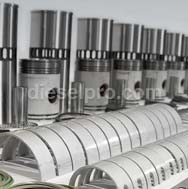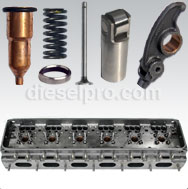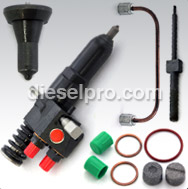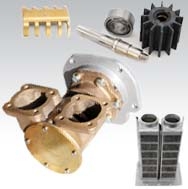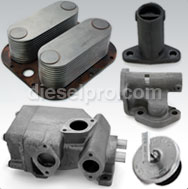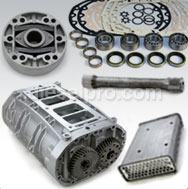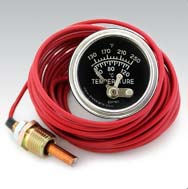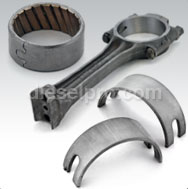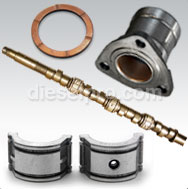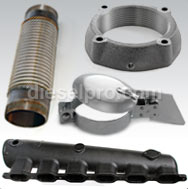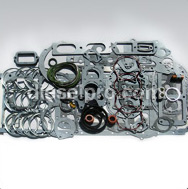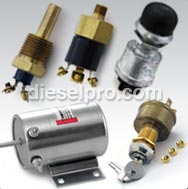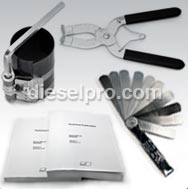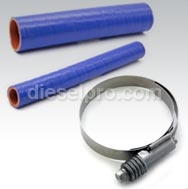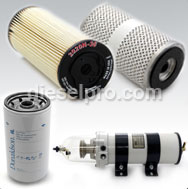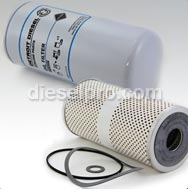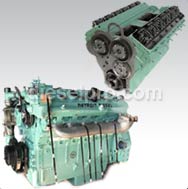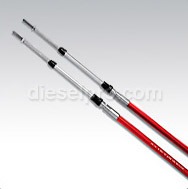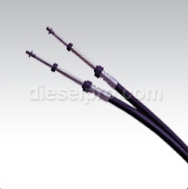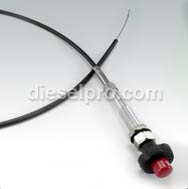The Detroit Diesel 12V71 Naturally Aspirated engine—commonly referred to as the 12V71N—is one of the most dependable heavy-duty diesel engines ever built. As part of the iconic Detroit Diesel Series 71 family, it uses a two-stroke, V12 configuration and operates without a turbocharger, relying instead on a Roots-type blower for air induction. This mechanical simplicity makes it highly serviceable and durable in demanding environments such as commercial marine fleets, remote industrial sites, and military field equipment. At Diesel Pro Power, we provide complete aftermarket support for this engine, including overhaul kits, replacement cylinder heads, cooling system components, and other critical parts. Below is a detailed technical summary of the 12V71N and a breakdown of the most common real-world applications where this engine continues to perform reliably. Engine Type: Two-stroke diesel engine Configuration: 12-cylinder V (60-degree angle) Displacement: 852 cubic inches (13.96 liters) Bore x Stroke: 4.25 in x 5.00 in (108 mm x 127 mm) Cylinder Heads: Six (each head covers two cylinders) Crankshaft Bearings: Seven main bearings Firing Order: 1R-5L-3R-6L-2R-2L-4R-1L-6R-3L-5R-4L Rotation: Standard or opposite (dependent on marine use) Fuel System Type: Mechanical unit injector (one per cylinder) Aspiration: Roots-type blower (naturally aspirated, no turbocharger) Compression Ratio: 17:1 Fuel Injection Pressure: ~2,000 psi at injector tip Fuel Consumption (Full Load): 0.44 to 0.48 lb/HP/hr Air Intake: Ambient pressure through blower Horsepower Rating Range: 390 to 525 HP @ 2,100 RPM Peak Torque: Approximately 1,050 to 1,250 lb-ft @ 1,200–1,600 RPM Governed Speed: 2,100 RPM (adjustable up to 2,300 RPM depending on governor model) Idle Speed: Typically 600–650 RPM Horsepower output is influenced by injector size (e.g., N55, N60), RPM setting, and intended use (marine, generator, vehicle). Oil Type: SAE 40 (preferred), 15W-40 for variable climates Oil Capacity: 10 to 12 gallons (37.9 to 45.4 liters) Operating Oil Pressure: 40 to 60 psi Oil System: Gear-driven, full-flow lubrication with oil cooler Cooling Type: Water-cooled (heat exchanger or keel-cooled for marine units) Coolant Capacity: Approximately 8 to 10 gallons Water Pump Type: Gear-driven centrifugal pump Thermostat Range: 170–190°F operating temperature Overall Length: Approximately 80 inches Overall Width: Approximately 40 inches Overall Height: Approximately 50 inches Dry Weight: 3,050 to 3,200 lbs (varies by flywheel, mounts, and accessories) The 12V71N offers a robust footprint and is often mounted with accessory components for specific marine or industrial tasks, such as PTOs, power take-offs, or front-mounted water pumps. The 12V71N has long been a staple in the commercial and working marine sectors, especially for propulsion systems where throttle response is less critical than durability and runtime. Its naturally aspirated design offers reduced complexity, minimal boost-related stress, and more predictable maintenance cycles—ideal for vessels that operate in predictable RPM ranges. Pushboats and river barges Fishing trawlers and shrimp boats Small to mid-sized tugboats (low-speed duty) Marine dredging equipment Research and survey vessels Classic motor yachts and liveaboard conversions Auxiliary propulsion systems and wing engines In twin-engine marine configurations, two 12V71Ns can provide a combined 800 to 1,000 horsepower, suitable for harbor maneuvers, slow cruising, or inland freight operations. In industrial environments, the 12V71N has served as a primary power source for stationary equipment and portable systems alike. Its two-stroke cycle delivers dependable torque at lower RPMs, making it well-suited for tasks requiring consistent, extended operation. Stationary generator sets (prime or standby) Water transfer pumps for agriculture or flood control Industrial fire protection pumps (e.g., diesel-powered hydrant systems) Compressors for mining and construction Cement and asphalt batch plant engines Oilfield support systems, including pipe handling and winch rigs Operators choose the naturally aspirated 12V71 in these settings because of its straightforward mechanical systems—no turbos to fail, no sensors to replace, and minimal downtime due to electronics. Although largely phased out of active service, the 12V71N was used in many military vehicles and stationary systems throughout the 20th century. Its reliability in harsh field conditions and lack of electronics made it ideal for global deployment. Armored transporters and tank recovery vehicles Amphibious cargo crafts and landing vessels Mobile base generators and command center power units Deployed water pump systems in forward areas Tactical support vehicle conversions (repurposed for civilian use) Many surplus engines are still in use today in international civilian markets or repowered for marine use in commercial fishing boats. The naturally aspirated version of the 12V71 has also found a second life in various custom installations and vintage equipment repowers, thanks to its distinct sound, mechanical simplicity, and abundant parts availability. Vintage buses and coaches (e.g., GM and MCI models) Heavy-duty mobile cranes Material handlers and custom fabrication platforms Custom hot rod semi-trucks or exhibition builds Classic overland expedition vehicles Large land-based generators for event support or disaster recovery Because the engine is mechanically governed and doesn't require an electronic control module (ECM), it is easy to adapt into a wide variety of platforms. Constant RPM environments Remote or offshore locations with limited access to specialized parts Vessels or sites prioritizing uptime over speed Operators familiar with mechanical diesel platforms Fleets seeking to extend life of legacy infrastructure While the 12V71N offers impressive reliability and simplicity, it lacks the responsive power boost of the turbocharged variant. In applications demanding fast throttle response or sustained high RPM power, the 12V71 Turbo (12V71T) may be more appropriate. Marine Detroit Diesel 12V71 Component Maintenance Life The Legacy of the Detroit Diesel Marine 12V71 Engine & Its Use Today Detroit Diesel 12V71 Marine Engine Specifications (Turbo & Non-Turbo) Overview of the Detroit Diesel V71 Series Engines (6V71, 8V71, 12V71, 16V71) General Service Guidelines for Detroit Diesel V71 Series Engines (6V71, 8V71, 12V71, 16V71) Cylinder Block for Detroit Diesel V71 Series Engines (6V71, 8V71, 12V71, 16V71) Cylinder Head for Detroit Diesel V71 Series Engines (6V71, 8V71, 12V71, 16V71) Common Maintenance and Repair Needs for Detroit Diesel V71 Cylinder Heads (6V71, 8V71, 12V71, 16V71) Fuel and Air Systems for Detroit Diesel 6V71, 8V71, 12V71, and 16V71 Engines Injectors Maintenance for Detroit Diesel V71 Engines (6V71, 8V71, 12V71, 16V71) Governor Maintenance for Detroit Diesel V71 Engines (6V71, 8V71, 12V71, 16V71) Blowers Maintenance for Detroit Diesel V71 Engines (6V71, 8V71, 12V71, 16V71) Air Filters Maintenance for Detroit Diesel V71 Engines (6V71, 8V71, 12V71, 16V71) Fuel Leaks Troubleshooting for Detroit Diesel V71 Engines (6V71, 8V71, 12V71, 16V71) Air Intake Restrictions for Detroit Diesel V71 Engines (6V71, 8V71, 12V71, 16V71) Injector Malfunction Troubleshooting for Detroit Diesel V71 Engines (6V71, 8V71, 12V71, 16V71) Lubrication and Cooling Systems for Detroit Diesel 6V71, 8V71, 12V71, and 16V71 Engines Electrical and Exhaust Systems for Detroit Diesel 6V71, 8V71, 12V71, and 16V71 Engines Troubleshooting and Preventive Maintenance for Detroit Diesel 6V71, 8V71, 12V71, and 16V71 Engines Specifications and Torque Tables for Detroit Diesel 6V71, 8V71, 12V71, and 16V71 Engines Safety Considerations for Detroit Diesel 6V71, 8V71, 12V71, and 16V71 Engines Lubrication System: Comprehensive Guide For Detroit Diesel V71 Engines (6V71, 8V71, 12V71, 16V71) Oil Pumps for Detroit Diesel V71 Engines (6V71, 8V71, 12V71, 16V71) Oil Pressure Regulation For Detroit Diesel V71 Engines (6V71, 8V71, 12V71, 16V71) Oil Filters for Detroit Diesel V71 Engines (6V71, 8V71, 12V71, 16V71) Cooling System: Comprehensive Guide For Detroit Diesel V71 Engines (6V71, 8V71, 12V71, 16V71) Types of Cooling Systems for Detroit Diesel V71 Engines (6V71, 8V71, 12V71, 16V71) Key Components of the Cooling System for Detroit Diesel V71 Engines (6V71, 8V71, 12V71, 16V71) Raw Water Pump Specifics for Detroit Diesel V71 Marine Engines (6V71, 8V71, 12V71, 16V71) Importance of Cooling System Maintenance for Detroit Diesel V71 Engines (6V71, 8V71, 12V71, 16V71) Detailed Torque and Specifications For Detroit Diesel V71 Engines (6V71, 8V71, 12V71, 16V71) Step-by-Step Maintenance Procedures For Detroit Diesel V71 Engines (6V71, 8V71, 12V71, 16V71) Oil Pump Removal and Reassembly for Detroit Diesel V71 Engines (6V71, 8V71, 12V71, 16V71) Draining and Refilling the Cooling System For Detroit Diesel V71 Engines (6V71, 8V71, 12V71, 16V71) Troubleshooting Guide For Detroit Diesel V71 Engines (6V71, 8V71, 12V71, 16V71) Complete Parts Catalog for Detroit Diesel V71 Engines (6V71, 8V71, 12V71, 16V71) Comprehensive FAQ for Detroit Diesel V-71 Series Manual (6V71, 8V71, 12V71, 16V71)
Parts for Detroit Diesel 12V71 Non-Turbo for Australia
-
Select Parts Category
 Loading...
Loading... Detroit Diesel 12V71 Naturally Aspirated – Engine Specifications & Applications
Overview
Engine Specifications – Detroit Diesel 12V71 Naturally Aspirated
Core Engine Design
Fuel and Air System
Power and Torque Output
Lubrication and Oil System
Cooling System
Dimensions and Weight
Applications of the Detroit Diesel 12V71 Naturally Aspirated Engine
Marine Applications
Common Use Cases
Industrial and Stationary Equipment
Common Use Cases
Military and Defense Equipment
Common Use Cases
Heavy Equipment and Custom Installations
Common Use Cases
Final Notes on Operational Preferences
Best Use Conditions for the 12V71N
Limitations Compared to Turbocharged Versions
Additional Resources
Detroit Diesel 6V71, 8V71, 12V71, 16V71 Engine Tune Up



 Free US Calls: 1-888-433-4735
Free US Calls: 1-888-433-4735 International: 305-545-5588
International: 305-545-5588





